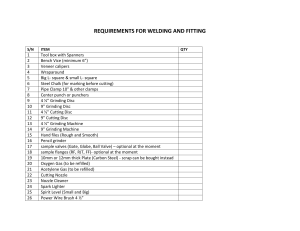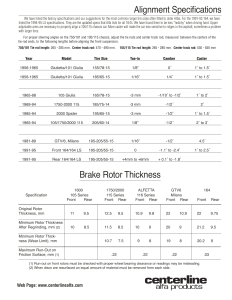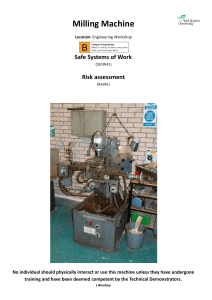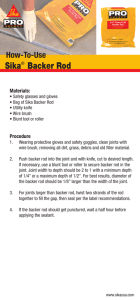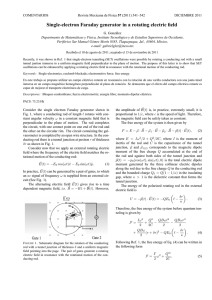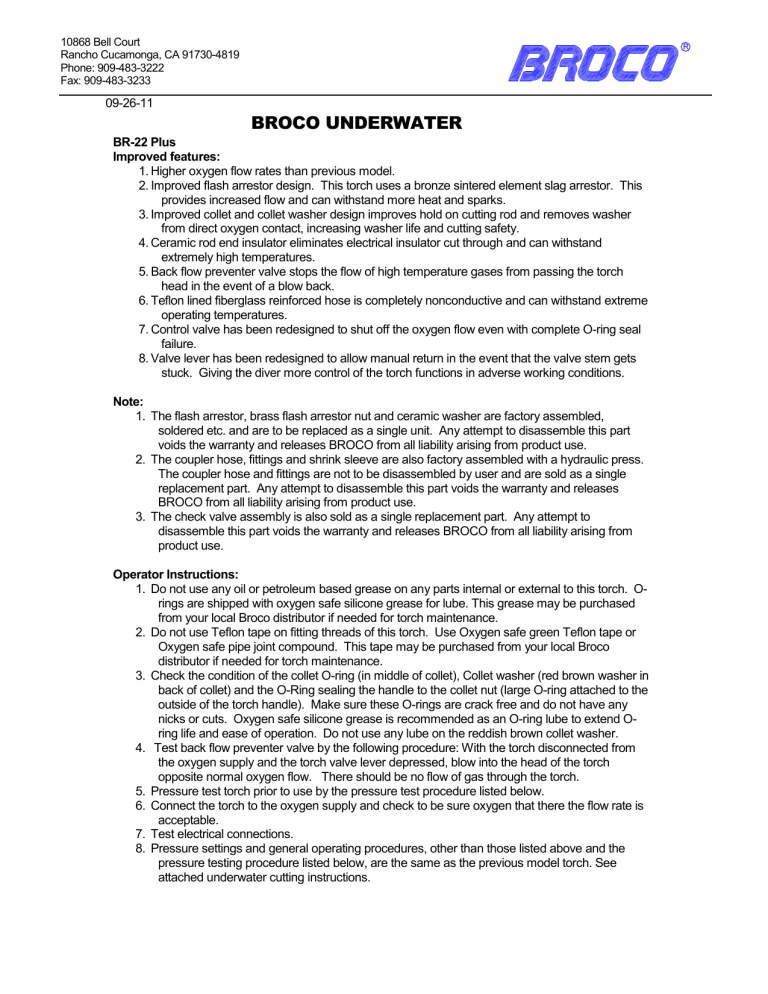
10868 Bell Court Rancho Cucamonga, CA 91730-4819 Phone: 909-483-3222 Fax: 909-483-3233 R 09-26-11 BROCO UNDERWATER BR-22 Plus Improved features: 1. Higher oxygen flow rates than previous model. 2. Improved flash arrestor design. This torch uses a bronze sintered element slag arrestor. This provides increased flow and can withstand more heat and sparks. 3. Improved collet and collet washer design improves hold on cutting rod and removes washer from direct oxygen contact, increasing washer life and cutting safety. 4. Ceramic rod end insulator eliminates electrical insulator cut through and can withstand extremely high temperatures. 5. Back flow preventer valve stops the flow of high temperature gases from passing the torch head in the event of a blow back. 6. Teflon lined fiberglass reinforced hose is completely nonconductive and can withstand extreme operating temperatures. 7. Control valve has been redesigned to shut off the oxygen flow even with complete O-ring seal failure. 8. Valve lever has been redesigned to allow manual return in the event that the valve stem gets stuck. Giving the diver more control of the torch functions in adverse working conditions. Note: 1. The flash arrestor, brass flash arrestor nut and ceramic washer are factory assembled, soldered etc. and are to be replaced as a single unit. Any attempt to disassemble this part voids the warranty and releases BROCO from all liability arising from product use. 2. The coupler hose, fittings and shrink sleeve are also factory assembled with a hydraulic press. The coupler hose and fittings are not to be disassembled by user and are sold as a single replacement part. Any attempt to disassemble this part voids the warranty and releases BROCO from all liability arising from product use. 3. The check valve assembly is also sold as a single replacement part. Any attempt to disassemble this part voids the warranty and releases BROCO from all liability arising from product use. Operator Instructions: 1. Do not use any oil or petroleum based grease on any parts internal or external to this torch. Orings are shipped with oxygen safe silicone grease for lube. This grease may be purchased from your local Broco distributor if needed for torch maintenance. 2. Do not use Teflon tape on fitting threads of this torch. Use Oxygen safe green Teflon tape or Oxygen safe pipe joint compound. This tape may be purchased from your local Broco distributor if needed for torch maintenance. 3. Check the condition of the collet O-ring (in middle of collet), Collet washer (red brown washer in back of collet) and the O-Ring sealing the handle to the collet nut (large O-ring attached to the outside of the torch handle). Make sure these O-rings are crack free and do not have any nicks or cuts. Oxygen safe silicone grease is recommended as an O-ring lube to extend Oring life and ease of operation. Do not use any lube on the reddish brown collet washer. 4. Test back flow preventer valve by the following procedure: With the torch disconnected from the oxygen supply and the torch valve lever depressed, blow into the head of the torch opposite normal oxygen flow. There should be no flow of gas through the torch. 5. Pressure test torch prior to use by the pressure test procedure listed below. 6. Connect the torch to the oxygen supply and check to be sure oxygen that there the flow rate is acceptable. 7. Test electrical connections. 8. Pressure settings and general operating procedures, other than those listed above and the pressure testing procedure listed below, are the same as the previous model torch. See attached underwater cutting instructions. BR-22 plus Cutting torch Pressure Test Procedure: 1. Connect the torch to its oxygen supply. 2. Set the regulator pressure to 130 Psi. (normal operating pressure is 90 psi, 130 is for testing purposes only) 3. Seal off the head of the torch by placing a sealed off cutting rod or solid brass test slug in the torch instead of a cutting rod. The test can also be done by removing the collet and placing a welding collet washer (solid rubber disk) inside the torch and then replacing the collet. Put a rod stub or full cutting rod in the torch and tighten normally (do not attempt to tighten nut without a rod in place as it will bend the tabs of the collet.) 4. Once the head is sealed, place the torch in a bucket of water, pressurize the torch and pull the torch lever to insure the entire torch is pressurized. 5. Keep the lever depressed underwater for at least 30 seconds and look for bubbles. There may be a few bubbles that come from any air that is trapped inside the torch but these will stop after a few seconds. If there is a steady flow of bubbles coming from the torch it should be repaired prior to use. 6. Remove the torch from the water and disconnect from oxygen supply. Depress torch lever to relieve pressure in the torch. Point head away from persons or property and remove the nut slowly hanging on to test plug. NOTE: Take care to disconnect from oxygen supply and depressurize before removing test plug as the test plug is under pressure and will shoot out of the torch when the collet nut is released. 7. If torch has leaks repair as required and retest. 9/28/2011 Page 2 CONFIDENTIAL Redesigned collet washer removes the rubber washer from the oxygen stream. The seal is made with the outside of the rod instead of the sharp end of the cu ng rod, increasing washer life. Flexible Insulator , gasket creates a ght seal reducing electrolysis and more effec vely insulates the operators hand from the electrical current. Large Area Sintered Element Slag Arrestor, increases flow and withstands more heat and sparks Non Return Valve, stops the flow of hot gasses from passing through the torch head in the event of a flash back. Woven Silica thermal insula on. Protects wire insula on. Ceramic washer provides non combus ble electrical isola on. Redesigned collet provides ghter hold on cu ng rod, and O-ring prevents the collet from falling out when the collet nut is removed. Redesigned valve to be er meter flow. Replaced seal with Teflon O-ring, and rearranged design to maintain seal in the event of O-ring failure. Teflon lined fiberglass reinforced hose. Can withstand extremely high opera ng temperatures. It is also combus on resistant in a pure oxygen environment. Shrink Sleeve around coupler hose and fi ngs. Reduces electrolysis on fi ngs and increases the effec ve distance between the electrically charged head and neutral handle. Valve lever and valve stem have been redesigned to allow manual return should the valve stem gets stuck. Moved O-ring loca on to reduce the chances of debris ge ng stuck in the valve stem. 4 3 REVISION HISTORY DESCRIPTION REV DATE 9/1/2011 2 1 PARTS LIST ITEM QTY B Part No. Part Description 1 1 BR011 Bronze check valve body 1 BR012 2 Bronze Check Valve Piston 1 BR013 3 Back up Ring 4 1 BR015 Check valve spring 5 1 BR019 Billet Control Valve Body 6 1 BR018 1/8 NPT Male x 1/4 Crimp Barbed Fitting 7 1 BR016 1/4 NPT Female x 1/4 Crimp Barbed Fitting 8 1 BR010 Bronze Sintered element slag arrestor 9 1 #1WC 6' #1 Welding Cable 10 2 BR017 Bronze Crimp Ferrule 11 1 BR026 Teflon lined Figerglass reinforced hose 12 1 114 SPRING, CONTROL VALVE 13 1 BR020A BR22A, LEVER 14 1 BR021 BR-22A, VALVE STEM 15 1 BR022 BR22A, CONTROL VALVE NUT 16 1 BRRN123 Dash 123 O-Ring Nut to Handle seal 17 1 BR003 B-22A TORCH HEAD 1 BR008 18 BR22 Flash Arrestor Nut 19 1 BR009 Ceramic flash arrestor washer 1 BRC38 20 Naval Bronze 3/8 UW Collet 21 1 BRW38 Silicone rubber sealing washer for 3/8" collet 1 BR004A 22 BR-22-A Brass Collet Nut insert 23 1 BR004 NUT, COLLET 1 BR001BB 24 Right Handle insulator 25 1 BR001BB Right Handle Half 26 1 BR001AA Left Handle insulator 27 1 BR001A Left Handle Half 28 1 119 10-32 UNF X 1 SLOTTED PAN HEAD MACHINE SCREW 29 5 BR023 1/4-20 UNC X 1.5 SLOTTED PAN HEAD NYLON SCREW 30 5 122 1/4-20 UNC HEX NYLON SCREW NUT 31 1 BR014 1/4" Stainless Steel Retaining ring 1 BRRN014 32 014 Neoprene O-Ring 33 1 238 7/16-14 Cup point Stainless Steel set screw 34 2 BRRT007 Dash 007 Teflon O-Ring 1 BRRN010 35 Dash 010 O-Ring 36 1 BRRS015 O-Ring 1 124 37 1/4 NPT Male to B CGA Adaptor 38 1 120 Brass Nylock Nut 10-32 Thread APPROVED D 29 27 1 17 34 9 2 C 3 4 16 7 31 8 11 6 19 21 18 D C 5 30 B B 20 32 25 23 37 12 14 28 35 15 34 36 38 13 A CONFIDENTIAL - NOT FOR PUBLICATION UNLESS OTHERWISE SPECIFIED ALL DIMENSIONS IN INCHES TOLERANCES: .X - ±.02 ANGLES .XX - ±.010 XX ± 1° .XXX - ±.005 X ± 5° .XXXX - ±.0005 DRAWN BY: DATE DRAWN: 9/28/2011 MATERIAL This drawing, including specifications or other data, is the property of Broco inc. The use thereof is conditioned upon the user's FINISH agreement not to disclose the drawing to others, or use for any other purpose, MASS without written permission from Broco Inc. 4 3 10868 Bell Court Rancho Cucamonga, CA 91730 GRH BR-22A Plus Assembly BR-22 Plus Drawing No. SIZE: N/A 2 C A TITLE: PART NO. BR-22 Plus DO NOT SCALE DRAWING SCALE: N/A 1 REV. 1 OF 1 BROCO UNDERWATER Underwater Cutting Products Operating Instructions Underwater cutting and welding equipment is potentially dangerous and can result in serious injury or death. This equipment must be used in strict accordance with the instructions provided. Users must read and understand these operating instructions thoroughly and follow all procedures when using the BROCO Underwater Ultrathermic cutting system. Underwater cutting and welding should be performed by trained commercial divers only and according to industry accepted safe diving practices. Always adhere to ANSI Z49.1:2005 "Safety in Welding and Cutting" standards or similar locally prevailing standards when using this equipment and follow industry accepted safe diving practices as found in the Association of Diving Contractors International "Consensus Standards for Commercial Diving." All personnel and supervisors engaged in underwater cutting operations must be familiar with these instructions, the correct use of underwater cutting equipment, and accepted safe commercial diving practices. Employers must provide operator training before allowing their personnel to begin using the BROCO Underwater Ultrathermic cutting system. Supervisors must ensure that all personnel become thoroughly familiar with all safety precautions prior to cutting. If you have any questions regarding the safe operation of BROCO Underwater Ultrathermic cutting systems, STOP! DO NOT ATTEMPT TO CUT UNDERWATER. Contact BROCO, Inc., Tel: 800-845-7259 / 909-483-3222, fax 909-483-3233, for technical information. See: American National Standard Z49.1:2005 "Safety in Welding and Cutting" published by the American Welding. Society, 550 N.W. LeJeune Rd., Miami, FL 33126, Tel. 305.443.9353 "Consensus Standards for Commercial Diving", published by the Association of Diving Contractors International, Inc., 5606 FM, 1960 West, Suite 202, Houston, TX 77069, Tel. 281.893.8388. OSHA Safety and Health Standards "29 CFR 1910" available from the U.S. Department of Labor, Washington, D.C. 20210, Tel. 202.693.1999. CUTTING EQUIPMENT To avoid serious injury or death, follow the safety information in this section and in all other warning sections. Modification of this equipment can cause oxygen leaks that can lead to an explosion. DO NOT modify this equipment or use it in any way not specified in these instructions. To prevent burns to your hands and body 1) Use only BROCO replacement parts; 2) Always release the oxygen lever to extinguish the torch while there is at least 2" of rod remaining; 3) DO NOT use a damaged Ultrathermic cutting rod; 4) Always insert the correct end (recessed, untaped) of the rod into the torch; 5) Always wear insulated suit and gloves. Using compressed air, oil, solvents or other material to clean the oxygen system can contaminate the oxygen system, cause internal burning in the torch or hose or cause an explosion. Always keep oil and grease away from oxygen cylinders, valves, regulators, hoses and fittings. A qualified and knowledgeable technician must perform all service on oxygen delivery parts. Using a torch without a flash arrester and screen can cause flashback in the torch and an explosion. DO NOT operate the torch without the flash arrestor and screen in place. Using a torch or cutting rods designed for surface use for underwater cutting can shock the diver. Always use a BROCO Underwater cutting torch and BROCO Underwater cutting rods. To prevent electrical shock to the diver and electrical damage to the diver's life support equipment, always ensure that the safety knife switch is open before changing cutting rods. DO NOT use a "burning bar" for underwater cutting operations. It can cause excessive gas buildup and an oxygen explosion. A burning bar is considered to be any underwater cutting rod operating with oxygen as a fuel source whose diameter is greater than 3/8" or length is longer than 36”. The use of underwater cutting rods from other manufacturers can cause flashbacks or internal burning and injury to the diver. Always use BROCO Underwater ultrathermic cutting rods with the BROCO Underwater BR-22 cutting torch. Equipment Required 1. Broco BR-22 cutting torch, preferred because it is designed for diver comfort, maximum oxygen flow, and ease of operation and maintenance. 2. Broco Underwater Ultrathermic cutting rods. 3. Broco HVR-4401 high volume two-stage oxygen regulator. 4. Single pole single throw or double pole single throw safety knife switch. (Rated 400 amps DC, unfused.) 5. C-type grounding clamp. (Appropriate for underwater use.) 6. 150-200 amp 100% duty cycle DC welding power source or 12v or 24v battery. 7. Size 1/0 (minimum) welding cables for torch power and ground leads. 8. Oxygen supply. (Gas only, 99.5% purity minimum.) 9. 3/8" inside diameter oxygen supply hose. (Regulator to torch. Taped to torch power cable at 2' intervals.) TOPSIDE (AT SURFACE) To avoid serious injury or death, follow the safety information in this section regarding topside safety and in all other warning sections. The use of damaged or worn components can cause equipment failure and result in injury. Before entering water, check equipment for leaks and replace damaged or worn components. To reduce the risk of injury in the unlikely event of regulator failure, DO NOT stand directly in front of or directly behind the oxygen regulator while opening the oxygen cylinder valve. Using the vessel's primary battery as a power source for rod ignition can damage or cause wear to the battery and could render the vessel inoperable. Always use a separate battery for cutting. Using alternating current (AC) for underwater cutting can electrocute the diver. DO NOT use AC power for underwater cutting operations. Use only direct current (DC) from a known power source. To avoid electrocution, DO NOT touch live electrical parts. 1. Before beginning, inspect components to ensure that: A. Hose and cables are in good condition with no visible cuts, cracking or splitting. Cable lug connectors should be securely attached and without visible excessive corrosion. B. All electrical connections are made watertight by carefully taping with UL approved electrical insulating tape. Tape should extend at least 4" up the cable on both sides of the connection. C. Cutting torch is in good condition with no visible gaps in the seam between the handle halves. Torch should be inspected to make sure flash arrestor, neoprene compression washer, collet washer and appropriate size collet are in good condition and in place. . . .continued TOPSIDE (AT SURFACE) CONT. To replace the collet: • Remove the collet nut and collet from the torch. • Make sure the neoprene collet washer is in place. • Insert the desired collet and replace the collet nut. D. Welding power source is DC output. E. Diver is equipped with proper diving dress and life support equipment in good condition. Rubber "linesman" gloves must be worn in addition to other gloves the diver may have. F. Appropriate eye protection is attached to the diver's faceplate. Use an approved welding lens. A minimum #4 shade is usually suggested for muddy water, #6 shade for average conditions and #8 shade or above for clear water, however the diver must use his best judgment as experience and conditions dictate. Note: Set the welding power source to 150 amps delivered to the torch; and the oxygen regulator delivery pressure to 90 psig over ambient pressure at depth. 2. Make sure the supply valve, regulator, hose and torch are clean and free of any grease, oil or particles. Purge the oxygen cylinder valve by opening it and then closing it. Attach the oxygen regulator to the oxygen supply and purge the oxygen cylinder valve by opening and closing it. Attach the oxygen supply hose to the regulator outlet. Make sure the supply valve, regulator, hose and torch are clean and free of any grease, oil or particles. Purge the regulator and hose with oxygen to clear any obstructions. 3. Attach the torch to the oxygen supply hose. 4. Set the regulator delivery pressure to 90 psig over the ambient bottom pressure or other pressure which may be required due to depth or nature of operation. Regulator delivery pressure must be increased with increased working depth. (See Table 1 - "Setting Oxygen Delivery Pressure for Depth.") 5. Purge the torch. Check fittings, connections and the torch for leaks using soap suds. 6. Attach the safety knife switch to the torch power lead. Attach the other end of the torch power lead to the torch cable. Attach a cable from the welding power source negative terminal to the safety knife switch. Ensure the safety knife switch is positioned within reach of the tender. The safety knife switch is activated only upon command from the diver. 7. Wrap all cable-to-cable connections with rubber strips and electrical tape. 8. Attach the ground cable to the welding power source positive terminal. Attach the other end of the ground cable to the ground clamp. 9. With the safety knife switch in the open position, start the welding power source and set output for 150 amps maximum at the rod tip. (See Table 2 "Setting Amperage for Cable Length and Size.") 10. Check polarity by immersing the rod tip and ground clamp in a bucket of salt water approximately 2" apart. Energize the rod by closing the safety knife switch. A stream of bubbles should rise from the rod tip. If not, reverse the polarity and retest. 11. Check amperage using a clamp-on or in-line gauge. Do not rely on dial indicators on the welding power source. UNDERWATER GAS/EXPLOSION DANGERS To avoid serious injury or death, follow the safety information in this section regarding gas/explosion dangers and in all other warning sections. Underwater cutting can lead to a buildup of potentially explosive gas mixtures that may be ignited by a spark from a cutting rod. Always flood area with an inert gas (such as argon or nitrogen) before cutting and/or vent the area by drilling holes behind and above the cut to allow the escape of gases generated during cutting. To avoid explosions caused by cutting into chambers or other areas filled with gas, check what is behind the material being cut. If there is a possibility that there is gas, flood area with an inert gas or vent the area by drilling holes to provide for the escape of gases. When melting concrete ensure entry hole is large enough to allow venting of all gases in and above work area. Cutting where there is a pressure differential – either blowing out or sucking in – can cause an explosion and injuries to extremities. Drill a hole and wait for pressure to equalize. Oxygen and hydrogen trapped in mud can cause an explosion. Before cutting below the mudline, jet and airlift or pump the mud from behind the cut. . . .continued UNDERWATER GAS/EXPLOSION DANGERS CONT. Explosive gases can accumulate within an energized underwater cutting rod. DO NOT energize a cutting rod until ready to initiate underwater cutting. Purge the cutting rod with oxygen by squeezing and holding the oxygen lever for at least four seconds with the rod in cutting position prior to energizing the cutting rod and initiating the arc. UNDERWATER OPERATIONS To avoid serious injury or death, follow the safety information in this section regarding diver safety in underwater operations and in all other warning sections. For the diver’s safety, never conduct underwater cutting or welding operations without a topside tender to monitor the diving operation and a standby diver for emergency response. To avoid burns, diver’s hands should not be closer than 4inches from the electrode tip. Using SCUBA breathing apparatus while performing underwater cutting or welding can result in electric shock and does not allow for communications with the topside tender. Always use surface supplied breathing air and hard-wire communications. DO NOT use life support equipment that has been modified from the manufacturer's original specifications. Failure to wear protective clothing while cutting can result in electrical shock. Divers must wear full wet or dry suits and rubber electrical insulating gloves (in good condition) to insulate their bodies and hands. A diver is at risk of severe electrical shock when cutting while only partially immersed in water. This splash zone is the most hazardous location where divers work. Always wear full wet or dry suit, rubber insulating gloves, appropriate eye protection, and dive helmet when working in the spash zone. To prevent damage to the diver’s life support equipment, serious injury or death, DO NOT touch the cutting rod to any metal on the diver's helmet, dress or equipment including any part of the diver’s body, hoses, cables and compressed gas cylinders. Wearing improper eyewear during underwater cutting can result in vision damage. DO NOT use cutting equipment without using an approved welding lens with a shade appropriate for the conditions of the water. Material may fall and injure the diver. Always be aware of the environment around you and position yourself and your life support equipment away from falling debris. If a diver's body comes between the cutting rod and the ground, the diver may become part of the electrical circuit and risk electrocution. Always face your ground and DO NOT turn your back to the ground connection. Oxygen pops can disintegrate the flash arrester and screen and cause serious injury to torch user. If diver feels an oxygen pop strong enough to move his hands or arms back, stop work immediately and bring torch topside to have flash arrester and screen checked. Failure to securely tighten collet nut may cause arcing and possible flashback and result in serious injury or death. Tighten the collet nut securely. If there is a loose connection between the rod and collet nut, oxygen bubbles may escape from the collet nut when operating torch. If bubbles escape, remove and reinsert the rod against the collet washer. If bubbles continue to escape, stop using the torch immediately and have it repaired. . . .continued UNDERWATER OPERATIONS CONT. Note: Broco Underwater Ultrathermic cutting rods will continue to burn as long as the oxygen flow is maintained, even with the power off. The oxygen lever must be released to extinguish the cutting rod. 1. Ensure the safety knife switch is in the open position and the welding machine is turned off prior to securing the ground clamp to the workpiece as close to the area to be cut as possible. Ensure the ground clamp is away from the diver as he proceeds to cut. 2. Check that the oxygen delivery pressure is correctly set by squeezing the torch lever to release a stream of oxygen. A 6” jet of oxygen should issue from the cutting rod tip. 3. Loosen the torch collet nut 1/2 turn. 4. Insert the end of the Broco Underwater Ultrathermic cutting rod that has the recessed internal wires into the collet opening until it bottoms on the collet washer. 5. Tighten the collet nut to lock the rod in place. 6. Check for oxygen leaks at the collet nut and around the collet by squeezing the oxygen lever. If a leak exists: make sure the rod is firmly seated on the collet washer; inspect the rod for damage; inspect the collet washer for damage and replace if necessary. 7. Place the tip of the rod against the work at the point where the cut is to be initiated and squeeze the oxygen lever for four seconds to purge the rod and torch. 8. With the oxygen still flowing call for the current to be switched on. The tender will close the safety knife switch. 9. Draw the tip of the cutting rod across the work to strike the arc. 10. Once the arc is struck and the rod ignited, pull (drag) the cutting rod along the line to be cut. The angle of the rod to the work should be between 30 and 90 degrees, depending on the metal thickness. 11. Maintain pressure to keep the rod against the work. Keep the tip of the rod in the puddle at all times. Move slowly at first, making sure full penetration is achieved. As cutting speed is increased, back spray and increased cutting noise will indicate insufficient penetration. Note: Do not try to hold an "arc". Keep the tip of the burning rod in direct contact with the target material at all times. Hold the rod "like a pool cue" with your free hand approximately 4" from the rod tip for a more stable cut. Keep moving the hand back as the rod consumes. 12. When the rod has burned to within approximately 3" of the torch collet nut call for the current to be switched off. 13. Lift the rod from the work and release the oxygen lever to extinguish the cutting rod. 14. After the tender has confirmed the current is off, loosen the collet nut 1/2 turn and remove rod stub from the torch. 15. Insert a new cutting rod and repeat the process until the cut is complete. Note: When cutting or melting non-conductive materials such as concrete, rock, coral, mastic, rope or marine growth, a striker plate (consisting of a steel or copper plate connected to the ground cable) is necessary to initiate the arc and light the rod. Once the rod is ignited, maintain the oxygen flow and bring the rod into contact with the target material. Table #1 Setting Oxygen Delivery Pressure for Depth Depth ft m 33 10 40 12 60 18 80 24 100 30 120 37 140 43 160 49 180 55 200 61 220 67 240 73 260 79 280 85 Pressure Gauge Setting psig bar 108 7.4 112 7.6 123 8.4 134 9.1 145 9.9 155 10.5 166 11.3 177 12.0 188 12.8 199 13.5 210 14.3 221 15.0 232 15.8 243 16.5 Calculate regulator gauge pressure setting as follows: For every 10' of hose required, add 1 psig to the 90 psig necessary at the tip. This compensates for frictional line losses. Additionally, add 0.445 psig for every foot of working depth. Table #2 Setting Amperage for Cable Length and Size* Length of Power Cable (supply to work distance) ft m 150 46 200 61 250 76 300 91 350 107 400 122 450 137 500 152 Amperage setting for Cable Size # 1/0 #2/0 #3/0 155 152 150 157 154 152 159 156 154 161 158 156 163 160 158 165 162 160 167 164 162 169 166 164 *The increases in amperage compensate for resistance losses. For greater lead lengths, add 2 amperes per fifty feet to settings. TROUBLESHOOTING Broco Underwater Ultrathermic cutting rods are different from steel tubular cutting rods in that Broco Underwater Ultrathermic cutting rods require higher oxygen flow and lower amperage. Additionally Broco Underwater Ultrathermic cutting rods require direct contact with the work, not maintenance of an arc. Most operational problems stem from operators using steel tubular cutting rods' setup and cutting techniques. Oxygen supply problems: 1. Efficient cutting with Broco Underwater Ultrathermic cutting rods relies on high volume unobstructed oxygen flow. With inadequate oxygen flow, the rod can burn without significantly affecting the work. Symptoms include: the rod burning longer than 60 seconds of continuous use; cuts of less than 12" in 1/2" thick steel plate; and an oxygen jet of less than 6" length underwater. Solutions: A. Ensure that a high volume two-stage oxygen regulator and 3/8" oxygen hose are being used. B. Ensure that the hose is not kinked, pinched or obstructed. C. Ensure that the oxygen cylinder valve (valves if using a manifold system) are fully opened. . . .continued 2. The Broco Underwater Ultrathermic cutting rod requires oxygen of at least 99.5% purity to sustain ignition without power. Cutting with continuous power, a reduction in the purity of the oxygen by 1% can decrease cutting efficiency by 25%. Note: The U.S. Navy Underwater Cutting and Welding Manual, NAVSEA 0929-LP-000-8010, gives estimates for the 3/8" Broco Ultrathermic cutting rod at the high end of these ranges. Solution: The Broco Underwater Ultrathermic cutting rod will melt all of these materials. Make sure that the tip is firmly buried in the work. Saw and wedge cutting may be necessary. Maximum cutting efficiency may be achieved by burning a series of holes through the piece prior to cutting across it. If the rods continuously extinguish underwater, or burn erratically, the problem is probably poor quality oxygen. A. Obtain a source of oxygen from a different, unrelated supplier. Note: Since a gas supplier will usually have all his oxygen coming from one manufacturer, changing cylinders for one filled at the same place or time will not solve oxygen purity problems, Using oxygen of other manufacture will either solve or rule out an oxygen purity problem. Power source problems: 1. If the rods consume too quickly, it is likely the welding power source is delivering greater than 150 amps. Solution: A.Use an in-line or clamp type ammeter to verify current output. Adjust as necessary. SURFACE PRACTICE FOR NEW USERS If you are a new cutting torch user, to avoid serious injury or death, follow the safety information in this section regarding surface practice for new users and in all other warning sections. Fumes from burning tape can cause respiratory injury. Always remove the tape insulation from underwater cutting rods before burning at the surface and keep your head away from the fume plume. Cutting torches can cause burn injuries. Always wear adequate protective clothing, welder's gloves, and face and eye protection specifically designed for burning (use a #6 welding lens if using a battery and a #10 with a welding machine). 1. Cutting with Broco Underwater Ultrathermic cutting rods requires practice. A diver with surface arc welding or cutting qualifications will get excellent results underwater in a short time. 2. Burning at least three or four rods on the surface before attempting to cut underwater is essential to gaining maximum proficiency with the Broco Underwater Ultrathermic cutting system. 3. Do not try to "maintain an arc." Instead practice metal to metal contact, keeping the rod tip in the molten puddle, and adjusting travel speed to ensure complete penetration. TECHNIQUES Note: Continuous power is recommended for cutting with the 1/4" diameter Broco Underwater Ultrathermic cutting rod, otherwise it is difficult to maintain ignition. Cutting Steel The 1/4" diameter Broco Underwater Ultrathermic cutting rod may be used for cutting steel up to 1/2" in thickness for maximum cutting economy. The 1/4" rod leaves a narrow kerf and is preferable for fine cutting. In bad visibility or for thicker steels, the 3/8" diameter cutting rod will give better production. For materials 1/2" thick or thicker, the 3/8" rod is preferable. For metal several inches thick, employ saw and wedge cutting (analogous to chopping wood) to achieve full penetration. "Rule of Thumb" estimates: ROD DIA. /4” /4” 3/ ” 8 3/ ” 8 3/ ” 8 1 1 PLATE THICKNESS /4” /2” 1/ ” 2 1” 11/2” 1 1 RANGE OF CUT PER ROD 20”–25” 10” – 15” 12” – 20” 9” – 14” 8” – 12” Cutting Cast Iron, Stainless Steel and Non-Ferrous Metals Cutting Thick Non-Ferrous Metals Note: Increase oxygen delivery pressure to 110 psig over ambient pressure for metal over 3" in thickness. Create a puddle and dip the rod tip slightly below the surface of the molten metal. From time to time push the cutting rod deeper into the metal to wash it out and blow the slag away. Cutting (Melting) Concrete and Rock Note: Always use the 3/8" diameter Broco Underwater Ultrathermic cutting rod when cutting concrete or rock. Light the rod by striking the tip against a copper or steel plate attached to the ground cable. Keep the oxygen lever depressed and raise the rod from the plate to the workpiece. Call for the current to be switched off. Press the rod tip into the material to create a molten pool. While melting through the material, periodically move the rod in and out and around to enlarge the hole to vent gases and to blow the molten material away. Cutting Rope and Wood Light the rod by striking the tip against a copper or steel plate attached to the ground cable. Keep the oxygen lever depressed and raise the rod from the plate to the workpiece. Call for the current to be switched off. Apply firm pressure to the tip to keep the maximum heat in direct contact with the material to be cut. In ship work, the rod may be angled or bent up to 90 degrees to prevent damage to the hull, shaft or stern tube. On wire rope the 1/4" diameter rod may be used for finer cut control. When using the 1/4” rod, continuous metal to metal contact is necessary to maintain rod ignition. Using 3/8" Broco Underwater Ultrathermic Cutting Rods With a Battery Note: Use of a battery power source is not recommended for cutting at depths below 60 fsw. A vehicle or boat battery (12v or 24v DC) may replace a welding machine as the ignition power source. The use of a safety knife switch is recommended, although jumper cables may be used as the make/break connection. To preserve battery life, the tender must disconnect the battery immediately on the diver's command once the rod is ignited. Broco, Inc. 10868 Bell Court Rancho Cucamonga, CA 91730 USA Ph: (909) 483-3222 (800) 845-7259 Fax: (909) 483-3233 e-mail [email protected] www.Brocoinc.com www.strongweldingproducts.com © Copyright 2007 by Broco, Inc., all rights reserved. Any reproduction in whole or in part without the express written permission of Broco, Inc. is expressly prohibited.
